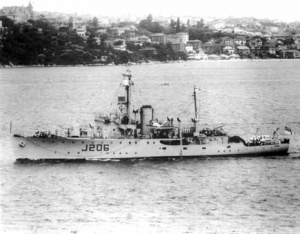
HMAS Lithgow (Allan C Green, State Library of Victoria).
The refit was completed on 5 March 1943 and the following day Lithgow began 9 months of escort and anti-submarine duty on the Queensland coast. At around 12:30 on the morning of 19 December 1943, Lithgow was diverted from its own convoy escort duties to render assistance to convoy TN 192. Seven of the 8 merchant vessels in the convoy, along with one of the escorts, HMAS Gladstone (I), had run aground on Bougainville Reef on the Great Barrier Reef. By the time Lithgow arrived just before 6:00 that morning, Gladstone had managed to refloat herself and was waiting for daybreak in company with the other convoy escorts, HMA Ships Gympie (I) and Stawell (I), just clear of the reef. The vessels Colorado, Ambrose Bierce and City of Fortworth had also all managed to free themselves and, with Lithgow and HMAS Castlemaine arriving to assist, and its own starboard propeller damaged, Gladstone detached at just after 7:00am to escort the trio back to Cairns.
Lithgow, along with Gympie, Stawell and Castlemaine, began disembarking troops from the stricken vessels at just after 9:00am. With all the troops transferred by 11:30 that morning, Lithgow began escorting those ships that were able to proceed back to Cairns early in the afternoon, arriving at around 7:00 that evening and subsequently returned to its own escort duties. All of the remaining ships were quickly refloated suffering varying degrees of damage.
The year of 1944 began with escort duties to New Guinea, followed by the ship’s annual refit at Melbourne. In April Lithgow arrived at Milne Bay to begin a period of 10 months escort and anti-submarine operations in New Guinea waters. It was in constant service to Langemak, Hollandia, Madang, Wakde, Biak, Morotai, Noemfoor and Mios Woendi.
A 7 week refit at Williamstown in April and May 1945 was followed by a return to New Guinea waters. In June and July the ship took part in Allied operations in the Solomons, supporting the land forces with a series of bombardments against enemy held territory. Lithgow remained based on the Solomons until the end of September 1945, operating as a minesweeper in the latter period. It was present at the Japanese surrender at Rabaul. October was spent in New Guinea waters, the ship ending its active war career when it entered Sydney Harbour on 1 November 1945.
In 1946 and 1947 Lithgow operated as a unit of the 20th Minesweeping Flotilla. It was constantly employed on minesweeping duties, in 1946 in the New Britain/Solomons area and on the Queensland coast the following year. Its seagoing career ended in January 1948 when it arrived at Fremantle, finally paying off into the Reserve Fleet on 8 June 1948, having steamed 178 000 miles and being under way for almost 20 000 hours.


